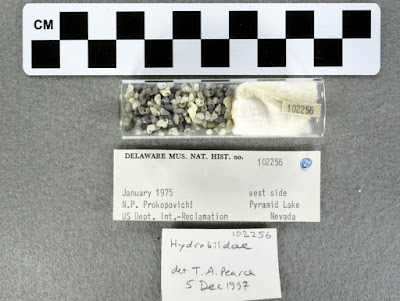kw: species summaries, natural history, natural science, museums, research, photographs
This is not exactly a species summary because the shells shown here have not been identified. I may get a chance to compare them with examplars of various species in its family in the DMNH collection, but it is more likely to await a visit from a freshwater snail expert. Several are known to visit from time to time.
The classification of species in the family Hydrobiidae has been brought pretty well under control, unlike the family Pleuroceridae on which I've focused the past several species accounts. This closeup through a low-power microscope of shells that seldom exceed 5mm in length illustrates the characteristic look of a Hydrobiid: the spire greater than the shell width but not exceedingly so, a straightforward conical spiraling shape, and a round-to-teardrop shaped aperture.
This species in particular has a ridge running along the whorls, so I suspect a species with "carina" in its name, though it may instead be Pyrgulopsis nevadensis Stearns, 1883, considering where these were collected! Hmmm, maybe I'll track this one down; few Hydrobiids are carinate.
I chose this lot to illustrate more about museum process. At the time this lot was obtained from the Department of the Interior there was little information entered on lot labels in general. The space below the museum name, where the identification is normally presented had nothing filled in at that time. Assuming the species I named above is found to be correct, a newer label will have the following in that space:
Hydrobiidae
Pyrgulopsis
nevadensis Stearns,1883
The date below is the date of collection, followed by the collector's name. Older lot labels, mainly prior to about 1940, designate the collector with the Latin abbreviation leg. Recent usage further abbreviates this to the "bang" or exclamation point. The right side of the label below the catalog number is devoted to the collecting locality. A specimen is most valuable when its original location ("provenance" is the favored term) is most accurately known. Material donated to a natural history museum that cannot be located at least to the country is pretty useless and is likely to wind up in a "show cabinet" if it is showy, and in a grab-bag for giveaways otherwise.
The other label shows that Dr. T. A. Pearce, currently at the Carnegie Museum of Natural History in Pittsburgh, identified ("det" means "determined") the family this lot belongs to, in 1997, but went no further at that time. He was here for a conference a few days ago, the 18th Mid-Atlantic Malacologists meeting, aka MAM, but didn't take a look at the Hydrobiids. Maybe on a future visit.
Subscribe to:
Post Comments (Atom)





No comments:
Post a Comment